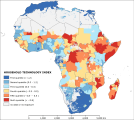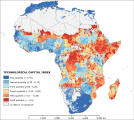household technology
Type of resources
Available actions
Topics
Keywords
Contact for the resource
Provided by
Years
Representation types
Update frequencies
status
Resolution
-

The “household technology index” relates to the diffusion of daily necessity technology in a certain area in 2010. High rate of access to such technology is an indicator of quality of life and wellbeing condition of the population, and thus, those with the capacity to cope and face better climate change impacts. The index results from the first cluster of the Principal Component Analysis preformed among 10 potential variables. The analysis identifies four dominant variables, namely “access to improved water source”, “access to improved sanitation facilities”, “electrification rate” and “mobile phone subscriptions”, assigning an equal weight of 0.25 to the four variables. Before to perform the analysis “electrification rate” and “mobile phone penetration” were log transformed to shorten the extreme variation and then with the other two variable were score-standardized (converted to distribution with average of 0 and standard deviation of 1) in order to be comparable. The first administrative level data for the “access to improved water source” (the share of the population with reasonable access to any of the following types of water supply for drinking: household connections, public standpipes, boreholes, protected dug wells, protected springs and rainwater collection. Reasonable access is defined as the availability of at least 20 liters a person per day from a source within one kilometer of the user’s dwelling.) and “access to improved sanitation facilities” (the share of the population with access to comprise flush toilets, piped sewer systems, septic tanks, flush/pour flush to pit latrines, ventilated improved pit latrines, pit latrines with slab and composting toilets) were gathered from DHS, UNDP National Human Development Reports, WHO/UNICEF statistics, and in some cases national survey data (data range from 1998 to 2012). Tabular data were linked by first administrative unit to the first administrative boundaries shapefile (FAO/GAUL) and then converted into raster format (resolution 0.5 arc-minute). The first administrative level data for the “electrification rate” of 2006 (percentage of population with access to electricity) was produced by NOAA National Geophysical Data Center. It is an estimation based on night light satellite picture. Tabular data were linked by first administrative unit to the first administrative boundaries shapefile (FAO/GAUL) and then converted into raster format (resolution 0.5 arc-minute). The country based data for the “mobile phone subscriptions” were gathered from World Bank. It records the average number of subscriptions to a public mobile telephone service using cellular technology per 100 people in the period 2008-2012. Post-paid and prepaid subscriptions are included. Tabular data were linked by country unit to the national boundaries shapefile (FAO/GAUL) and then converted into raster format (resolution 0.5 arc-minute). These variables have been identified as a key indicator of adaptive capacity, and thus vulnerability, at many levels by different authors (e.g. Brooks et al. 2005; Bollin & Hidajat 2006). In particular improved sanitation facilities prevent insect and animal contact, which are agents of diarrhea, and also reduce other non-diarrhea related health outcomes. Improved water sources can significantly lower the risk of water-borne diseases, which, in turn, has in its turn a positive impact on people's health status (Esrey & Habicht 1986). In other words, improved sanitation facilities and water sources should get better growth rates and reduce child mortality rates. This dataset has been produced in the framework of the “Climate change predictions in Sub-Saharan Africa: impacts and adaptations (ClimAfrica)” project, Work Package 4 (WP4). More information on ClimAfrica project is provided in the Supplemental Information section of this metadata.
-

The “technological capital index” symbolizes the physical means that determine the potential adaptive capacity degree of a particular unit of analysis in 2010. It is linked with the diffusion of basic life technology and infrastructure (e.g. transportation network). It is the combination of two underlying indexes: the “household technology index” and the “infrastructure index”. These original indexes correspond to the two principal components recognized by Principal Component Analysis among 10 potential variables. The analysis assigned relative weights to the “household technology index” and the “infrastructure index”, that are 0.62 and 0.38, respectively. This dataset has been produced in the framework of the “Climate change predictions in Sub-Saharan Africa: impacts and adaptations (ClimAfrica)” project, Work Package 4 (WP4). More information on ClimAfrica project is provided in the Supplemental Information section of this metadata.
 FAO Map Catalog
FAO Map Catalog